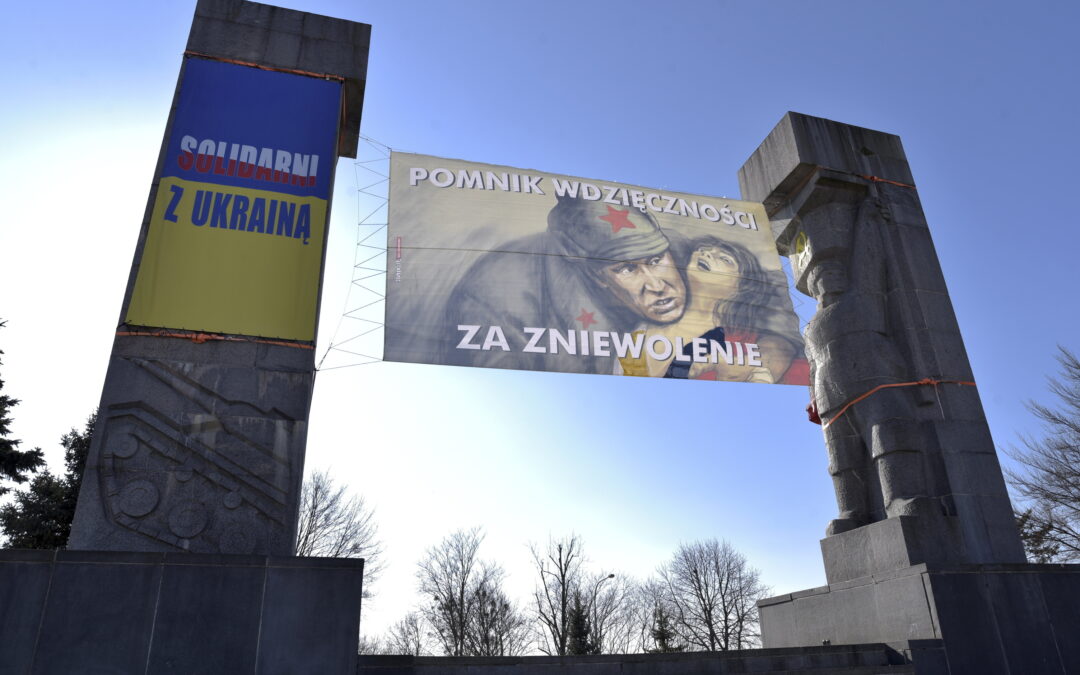Three further monuments to the Soviet Red Army will be dismantled in Poland this week, as the country’s state Institute of National Remembrance (IPN) renews its drive to “decommunise” public spaces amid Russia’s war in Ukraine.
“History is becoming a living experience before our very eyes,” said Karol Nawrocki, the head of the IPN, last month. “Dressed in the uniform of the Russian Federation, with Lenin and Stalin in their heads and hearts, Russian soldiers are ‘liberating’ Ukraine by murdering women and children.”
At the end of World War Two, Soviet forces drove back the German Nazi occupiers in eastern Europe, in what Russia today calls a “liberation” but which many people of the countries in question, including Poland, see as the replacement of one totalitarian regime with another.
Russia’s invasion of Ukraine has been “accompanied by the glorification of Russian imperialist traditions and the relativisation of the crimes of Soviet communism”, continued Nawrocki.
“This makes us even more aware of the importance of removing names and symbols promoting communism from the Polish public space,” he added.
At a ceremony last month to remove a Red Army monument in the village of Chrzowice, Nawrocki likened the communist red star to the Nazi swastika. “In this symbol we see the criminals of Katyn [the Soviet murder of 22,000 Polish officers and intellectuals]…and the enslavement and colonisation of Poland.”
The issue of communist-era monuments has long been controversial in Poland. Many – including the current national-conservative government – have pushed for their removal. But Russia has criticised such actions and, sometimes, local Polish communities have fought to keep objects they have become attached to.
Three such monuments are set to be dismantled tomorrow, with Nawrocki himself attending one of the events, in the village of Siedlec, which will also be streamed live by the IPN.
The monument that is now in Siedlec was originally created to mark the burial site of 130 Red Army soldiers, but later both it and the remains of the soldiers were moved to different and separate locations.
The two other memorials to be removed tomorrow are in the villages of Międzybłocie – which features a plaque dedicated to the memory of nine Soviet soldiers – and Garncarsko, whose inscruption reads: “Eternal glory to the heroes who died for the honour and independence of the Soviet homeland.”
A “decommunisation” law passed by the current government in 2016 required local authorities to remove any objects and names that “propagate communism or other totalitarian systems”. While that has led to many monuments being removed and street names being changed, some still remain.
“It is high time to catch up in this area,” says Nawrocki, who last week revealed the IPN has a list of 60 municipalities with symbols that should be removed. If they do not cooperate, they “can expect a visit”, he says.
Last week, Nawrocki wrote to the mayor of Rzeszów, a city in southeastern Poland, calling on him to comply with the 2016 law by finally removing a large monument of gratitude to the Red Army in the city centre.
This week, local authorities in the city of Olsztyn will begin a telephone survey of residents asking for their views on the future of a similar monument, after Russia’s invasion of Ukraine renewed calls for its removal, reports Portal Samorządowy. Similar debates are taking place in a number of places around Poland.
Last week, the city of Dąbrowa Górnicza announced that it would remove two such monuments, with the mayor declaring that “Russia’s criminal aggression against Ukraine” had prompted the decision.
However, he also told the Polish Press Agency (PAP) that he “regretted [the fact] that the Polish government has transferred the problem of post-Soviet monuments exclusively to local authorities, not recognising certain threats resulting from the aggressive attitude of the Russian side”.
Dziś w centrum #Olsztyn zawisła swastyka. Podobno sam prezydent @grzymowicz zadzwonił na straż miejską żeby to ściągnęli.
Panie prezydencie, zaimponował mi pan. Dziękuję.A pomysłodawców tej idei wysłałbym na wycieczkę do Auschwitz gdzie przebywał autor pomnika… pic.twitter.com/Brrjxd8WWA
— Karol Grosz ✊🇪🇺 (@karolgr98) March 22, 2022
Russia has often criticised the removal of Soviet monuments in Poland, arguing that it not only dishonours the memory of those who “liberated” the country but also violates a bilateral agreement.
Poland points out that that agreement relates only to graves and war cemeteries, not separate monuments and symbols.
Earlier this month, local authorities and activists in the Russian city of Smolensk drove construction vehicles to a monument marking the burial site of victims of the Katyn massacre. They threatened to destroy it in response to the demolition of Soviet monuments in Poland.
Just for the context. In Poland there are 705 Russian WW2 and 1129 WW1 military cemeteries. There are even 11 of them from the time of the Napoleonic wars. All under protection of Polish authorities. There are only 2 Polish military cemeteries in Russia – in Katyn and Miednoye. https://t.co/90T8qcmE9z
— Sławomir Dębski (@SlawomirDebski) April 15, 2022
Main image credit: Robert Robaszewski / Agencja Wyborcza.pl

Daniel Tilles is editor-in-chief of Notes from Poland. He has written on Polish affairs for a wide range of publications, including Foreign Policy, POLITICO Europe, EUobserver and Dziennik Gazeta Prawna.




















